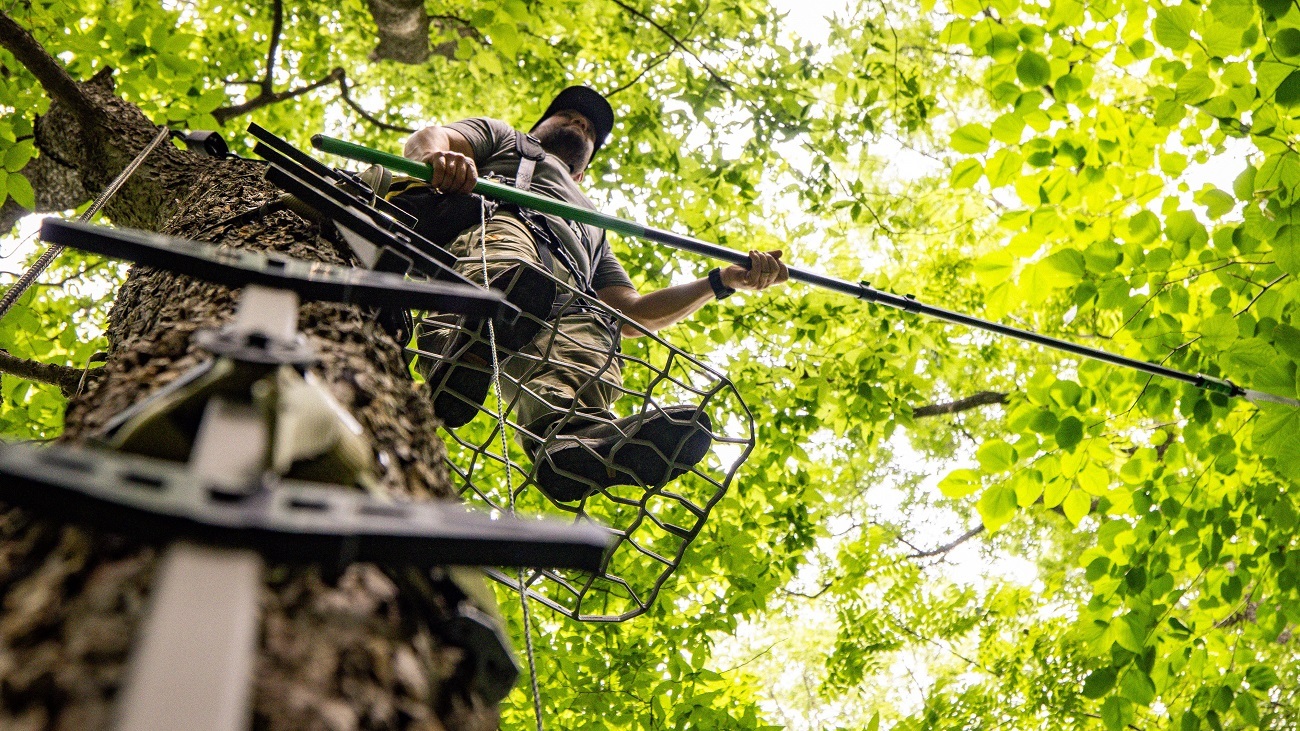Planning to hunt aloft this deer season? You’re in good company! A huge number of hunters use a tree stand (a platform anchored to a tree) when they head for the woods each fall. A stand is an effective way to hunt incognito and get a clean, ethical kill shot. But at an average elevation of 20 dizzying feet aboveground, they also pose risks. It only takes one misstep or broken strap to cause a fall and land you in the ER—or worse.
If you’ve had a slip or fall from your deer hunting stand, you know the importance of proper safety equipment and using it every time you climb. If you haven’t had a mishap, applying the info below can help you maintain your good record. Let’s review the risks of tree stand hunting and how to use stands safely.
Tree Stand Accidents Statistics
Are hunting tree stands that dangerous? How many hunters really fall from them? What are the odds it will ever happen to you? This Wisconsin DNR study found the more you hunt aloft, the more likely you will fall and require medical care. Let’s look at some sobering stats.
- Tree stand falls, not firearm accidents, are the largest source of hunting-related injuries and deaths in the US (Wisconsin DNR).
- Around 28% of archers have fallen/nearly fallen and 13% of firearm users have fallen/nearly fallen from a stand (Wisconsin DNR).
- Approximately 1 in 3 people who hunt from a stand will experience a fall resulting in injury (Deer & Deer Hunting).
- Around 81% of fall victims require surgery (Multicenter Study).
When Do Most Accidents Involving Tree Stands Occur?
Climbing up or down and installing/removing a stand is when most accidents involving tree stands happen. These factors researched by National Hunter Ed also top the list of common causes of falls from elevated stands:
- Incorrectly placing or using equipment
- Mistakes climbing into or out of a stand
- Using equipment damaged by exposure
- Hunter’s lack of knowledge of equipment
- Excessive wear or stress of equipment
Tree Stand Safety Tips
First, no deer is worth dying for or even breaking a leg over. That’s why safety should always come first. At Redmond Hunt, we practice these treestand safety basics before setting up or climbing any stand. Every time. No exceptions. They can also help you stay safe. Let’s talk about types of trees to utilize first.
How to Choose the Right Tree
Safety hunting aloft begins with selecting a good tree—because even the best safety system isn’t worth much if your tree snaps under your weight or with a little wind. So here are some things to look for when picking a tree for a tree stand:
- A healthy, living tree that’s sturdy enough to support your weight
- A straight tree that's within cover
- A tree that fits the size limits recommended in your stand’s instruction manual
- A tree with rough, scaly bark (like oak, maple, or pine) that straps can dig into
Practice These 6 Safety Rules
Follow these recommendations to help you reduce risk, stay in your deer hunting stand, and have a successful hunt. Good luck, and be safe out there this hunting season!

1. Inspect Safety Equipment
Has your elevated hunting stand sat quiet during the off-season or even been up for a couple of years? Then it’s time for a full-on inspection that includes your tree, hunting stand, and harness. Because your equipment is at the mercy of weather and squirrels, metal may rust, and straps might get chewed or frayed, putting it in danger of failing.
So, while your feet are still securely on the ground, search your stand for missing components or broken or loose parts. Also ensure straps and lines are intact, steps are secure, and your harness fits and is in good condition.
2. Check Your Lifeline
A tree stand safety line keeps you connected and safe from the time you leave the ground to when you get back down. Ensure your lifeline is in good working order and you’re clipped in before you climb, since many falls happen while ascending and descending stands.
3. Wear a Safety Harness
There are no exceptions, excuses, or buts here. Always wear a full-body tree stand safety harness to check your stand, scout, hunt—in short, anytime you go up.
Unfortunately, the number of hunters who use fall protection harnesses with every trip up or down the tree needs improvement. The Wisconsin DNR study says only 33% of archers and 23% of firearm hunters always use a harness. We can do better and hunt safer—avoiding injury or death and a lot of stress for ourselves and our families.
4. Follow the 3 Points of Contact Rule
Always have three points of contact on the steps or ladder of your stand to stay secure when climbing. That means having two hands and one foot or one hand and two feet on the ladder at all times. Also, watch for slippery steps from rain, frost, ice, or snow.
5. Use a Haul Line for Gear
Don’t try to pack your firearm or bow and climb to your stand if you can’t safely wear it. Instead, once you’re secured and seated, use a heavy cord to pull up your gear and weapon.
6. Have a Hunting Plan
When it’s time to hunt (or any time you visit your stand), tell someone which stand you’re hunting and how to get there. Leave a map if needed. Then text or call your contact when you’re safely secured in your stand and again when your boots are back on the ground.
Ready to test your knowledge of tree stand safety? Take this free 15-minute course from the Treestand Manufacturers Association. New to Redmond Hunt? Click below to learn more about our exceptional mineral products to help you attract, hold, and harvest deer!
© Redmond Hunt 2023. All rights reserved.

